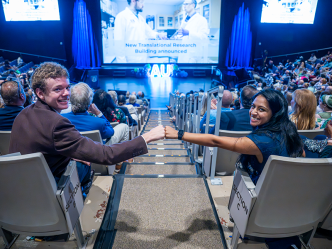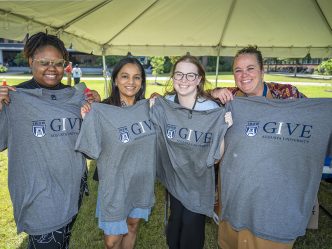World Tourism Day 2018, celebrated on Thursday, is the perfect time for a wake-up call. The digital transformation of one of the world’s largest industries has made tourism a double-edged sword for some cities.
Dr. Marsha Loda, associate professor of marketing at Augusta University’s James M. Hull College of Business, knows it very well.
For the past two summers, she and her students have seen firsthand how technology has impacted Asheville, North Carolina, the destination of an Augusta University study away trip focused on marketing and tourism.
“Students study and experience why Asheville is such a magnet for millennial tourists, the target audience that destination marketers are intensely trying to attract,” she said.
Since 2016, Asheville has used data and travel intelligence as well as geolocation technology to analyze consumer behavior and customize messages for potential tourists, according to Buncombe County Tourism Development Authority’s sales and marketing plan for the past three years.
The effort has paid off. Tourism has boomed in “Beer City, USA.”
Over the past three years, hotel room sales have increased by more than 11 percent and lodging sales have increased by more than 25 percent, according to the Buncombe County Tourism Development Authority’s 2017-2018 Annual Report. Visitors generated more than $3 billion in total sales for local businesses and nearly $370 million in tax revenue for the city.
The city of about 90,000 residents now welcomes almost 30,000 visitors — a third of its population — every day, according to the report.
But that marketing success comes at a price.
“The tourist influx has brought massive chain hotels, chain retailers, crowded streets and rising prices, as analytics and other cutting-edge marketing technologies identify Asheville as the place to move, to build and to visit,” said Loda, an expert in the hospitality and tourism industries. “Tourists impact cultures as well as physical environments. If technology has helped to promote tourism, it follows that cultural issues resulting from tourism growth are perhaps peripherally related to technology.”
The difference between how tourists and Ashevillians, who “pride themselves on authenticity and craftsmanship,” view the tourism industry is striking.
“When tourists are asked what they like least about Asheville, the answer is a resounding ‘nothing,’” Loda said. “When residents are asked what they like least about their city, the answer is an equally resounding ‘tourists.’”
This negative impact on residents and cities has become a worldwide problem as tourism continues to grow at a fast pace.
Nearly 4.1 billion passengers flew in 2017, more than in any other year to date, according to a report by the International Air Transport Association. International tourist arrivals also grew by 7 percent compared to 2016, the highest growth in seven years, according to a report by U.N.’s World Tourism Organization. The first four months of 2018 have also surpassed the World Tourism Organization’s forecast for international tourist arrivals, growing 6 percent compared to the same time frame in 2017.
“With increasing tourist numbers, tourism must be developed and managed in a sustainable manner for both visitors and local communities,” according to a recent report by the United Nations World Tourism Organization on how cities can manage the growth. “This is key when it comes to what is being labelled as ‘overtourism.’”
Ironically, part of the solution to overtourism has been to use technology to fight a problem technology helped create.
Only a few weeks before The Masters this year, for example, the Augusta Convention and Visitors Bureau still needed to fill hotel rooms in Augusta, said Lindsay Fruchtl, the bureau’s vice president for marketing. Geofencing technology enabled her team to reach potential tourists.
“We were able to take a mobile-first approach by retroactively capturing device IDs that frequent golf courses in a 200-mile radius,” Fruchtl said.
With that information in hand, her team created Masters-themed ads and targeted only the people who had “affinity for golf” and who had been to a golf course in the previous six months.
“This resulted in ultimately filling all rooms for Masters week,” she said.
To avoid potential problems with overtourism, however, Fruchtl said her team also created a series of videos targeting young women, couples and families to drive visitors to downtown and other areas of Augusta. This digital campaign had more than 1.7 million impressions with a .26 percent click-through rate.
Other cities have used carbon calculators to measure air pollutant emissions, vehicle monitoring systems to improve public transportation and visitor management technology to monitor the number of visitors an area can tolerate, Loda said.
The use of technology to curb overtourism and promote cultural and environmental sustainability, however, is not yet where it should be.
“The goal of sustainable tourism is laudable and lofty,” Loda said. “Strides are being made, but the reality is it’s still in its infancy.”
The goal of this year’s World Tourism Day is to raise awareness on how technology can help create more sustainable tourism.
“We must better understand the growing economic, societal and environmental impacts of technology and innovation in tourism if our sector is to sustain continuous and inclusive growth,” according to the World Tourism Day website. “We know that a digitally advanced tourism sector can improve entrepreneurship, inclusion, local community empowerment and efficient resource management, amongst other important development objectives.”
Loda says, however, that in reality, applying what is learned from technology isn’t easy.
“Knowing the volume of visitors a destination can tolerate without negatively impacting the environment is one thing, but deciding how to restrict visitors is quite another,” she said. “Should cities stop visitor traffic at their borders, or restrict airplanes from landing? The solutions are difficult.”
 Augusta University
Augusta University




